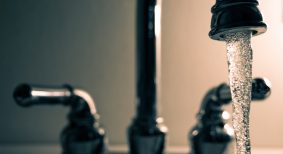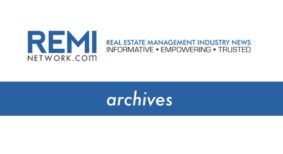For kids, an incoming storm typically brings sighs and choruses of, “Rain, rain, go away.” But for property owners and managers with rainwater harvesting systems on-site, regular downpours can mean a smaller water bill.
Here, water resources specialist Chris Despins explains how rainwater harvesting systems operate, their green benefits and the challenges building owners face when trying to incorporate a system into an existing building.
What is rainwater harvesting and how does it work?
Rainwater harvesting is the ancient practice of collecting and storing rainwater for later use. Modern rainwater harvesting systems work by collecting rainwater, typically from the roofs of homes or institutional, commercial or industrial buildings, storing it in a large tank, and then utilizing a pump and pressure system to distribute the rainwater to connected plumbing fixtures.
The systems can have elaborate treatment methods that use chlorine or ultra-violet (UV) lamps for disinfection, or simply use screens to remove debris like leaves and twigs. Ultimately, the treatment methods employed depend on what the property is using the rainwater for.
Each province regulates the use of harvested rainwater. Typically, it can be supplied to toilets and urinals, and used for outdoor landscape irrigation.
What benefits does rainwater harvesting offer property owners and tenants?
Rainwater harvesting systems allow property owners and tenants to use rainwater as a resource instead of having to remove it through roof drains, eaves troughs or parking lot catch basins.
Another benefit is that rainwater use reduces municipal water consumption, which helps cut down on a building’s water bill. It also reduces the need for municipalities to treat and pump water, a process that is both chemically and energy intensive.
How widespread is rainwater harvesting in Ontario? Is it a growing trend?
Farms and rural households have engaged in rainwater harvesting for centuries. However, its use in Ontario’s urban centres is relatively new – but growing rapidly.
Changes in the 2006 Ontario Building Code permitting the use of rainwater for non-potable (non-drinking) purposes, along with programs like LEED (Leadership in Energy and Environmental Design), have helped drive rainwater harvesting’s growth. A majority of LEED buildings, along with many other green buildings, now harvest rainwater for indoor and outdoor use.
Are there any incentives for property owners or managers to implement rainwater harvesting?
Municipalities throughout the Greater Toronto and Hamilton Area are adopting a variety of different policies (green building, stormwater management and water conservation) and incentive programs to promote the growth of rainwater harvesting.
One example is the Guelph Home Rainwater Harvesting System Rebate Program, which offers a $2,000 rebate to homeowners that install a rainwater harvesting system.
Builders or property owners are advised to contact their municipality and inquire about what policies and incentive programs are available, as it varies from place to place.
What barriers stand in the way of properties that want to participate in rainwater harvesting?
One of the challenges associated with rainwater harvesting is retrofitting existing buildings to incorporate these systems, as it requires installing dedicated pipes from the rainwater tank to the plumbing fixtures.
Routing the new plumbing in finished homes and buildings can be difficult. To address this issue in new construction, designers and contractors are advised to separately plumb all piping going to fixtures that can be served by non-potable water (for example, lavatories and showers) and keep them on a separate line. This way, future owners or tenants that want to install a rainwater harvesting system will have a much easier time retrofitting existing dedicated non-potable water supply pipe.
Chris Despins is a water resources specialist with Credit Valley Conservation, a community-based environmental organization dedicated to protecting, restoring and managing the natural resources of the Credit River watershed. He can be reached at cdespins@creditvalleyca.ca.







Nice article, Chris! We will share it with our network as well.